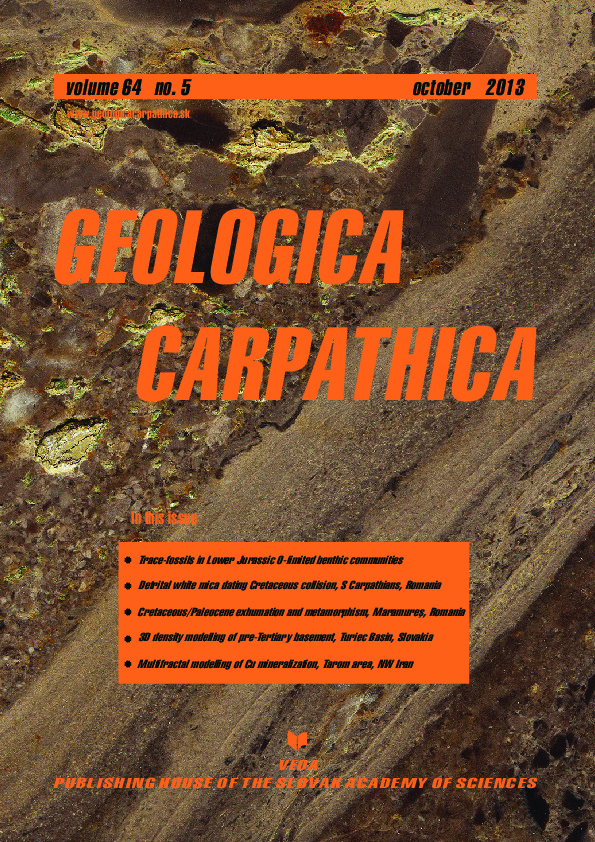Trace-fossil assemblages with a new ichnogenus in “spotted” (Fleckenmergel—Fleckenkalk) deposits: a signature of oxygen-limited benthic communities
Published: Oct 2013
Pages: 355 - 374
DOI: https://doi.org/10.2478/geoca-2013-0024
Authors: VLADIMÍR ŠIMO, ADAM TOMAŠOVÝCH
Abstract: Highly-bioturbated “spotted” limestones and marls (Fleckenmergel—Fleckenkalk facies) of the Early Jurassic, which were deposited in broad and recurrent deep-shelf habitats of the Northern Tethys, are characterized by rare benthic carbonate-producing macroinvertebrates. To address this paradox, we analyse trace-fossil assemblages in a ~ 85 m-thick succession of Pliensbachian spotted deposits (Zliechov Basin, Western Carpathians). They are dominated by infaunal and semi-infaunal deposit-feeders, with 9 ichnogenera and pyritized tubes of the semi-infaunal foraminifer Bathysiphon, being dominated by Chondrites, Lamellaeichnus (new ichnogenus), and Teichichnus. Lamellaeichnus, represented by a horizon- tal basal cylindrical burrow and an upper row of stacked convex-up gutters, was produced by a mobile deposit-feeder inhabiting shallow tiers because it is crossed by most other trace fossils. We show that the spotty appearance of the deposits is generated by a mixture of (1) dark, organic-rich shallow- and deep-tier traces (TOC = 0.16—0.36), and (2) light grey, organic-poor mottled or structurless sediment (TOC = 0.09—0.22). The higher TOC in shallow-tier burrows of Lamellaeichnus demonstrates that uppermost sediment layers were affected by poor redox cycling. Such conditions imply a limited mixed-layer depth and inefficient nutrient recycling conditioned by hypoxic bottom-waters, allowed by poor circulation and high sedimentation rates in depocenters of the Zliechov Basin. Hypoxic conditions are further supported by (1) dominance of trace-fossils produced by infaunal deposit feeders, (2) high abundance of hypoxia- tolerant agglutinated foraminifer Bathysiphon, and (3) high abundance of Chondrites with ~ 0.5 mm-sized branches. Oxygen-deficient bottom-conditions can thus simultaneously explain the rarity of benthic carbonate-producing macroinvertebrates and high standing abundance of tolerant soft-shell and agglutinated organisms in spotted deposits.
Keywords: Jurassic, Western Carpathians, community paleoecology, dysoxia, bioturbation, ichnofacies, trace-fossil assemblage
Download PDF documentVolume 64 no. 5 / October 2013
VLADIMÍR ŠIMO, ADAM TOMAŠOVÝCH
Trace-fossil assemblages with a new ichnogenus in “spotted” (Fleckenmergel—Fleckenkalk) deposits: a signature of oxygen-limited benthic communitiesFRANZ NEUBAUER, ANA-VOICA BOJAR
Origin of sediments during Cretaceous continent—continent collision in the Romanian Southern Carpathians: preliminary constraints from 40Ar/39Ar single-grain dating of detrital white micaHEIKE R. GRÖGER, MATTHIAS TISCHLER, BERNHARD FÜGENSCHUH, STEFAN M. SCHMID
Thermal history of the Maramure area (Northern Romania) constrained by zircon fission track analysis: Cretaceous metamorphism and Late Cretaceous to Paleocene exhumationMIROSLAV BIELIK, MARTIN KRAJŇÁK, IRINA MAKARENKO, OLGA LEGOSTAEVA, VITALY I. STAROSTENKO, MARIÁN BOŠANSKÝ, MICHAL GRINČ, JOZEF HÓK
3D gravity interpretation of the pre-Tertiary basement in the intramontane depressions of the Western Carpathians: a case study from the Turiec BasinREZA NOURI, MOHAMMAD REZA JAFARI, MEHRAN ARIAN, FARANAK FEIZI, PEYMAN AFZAL
Correlation between Cu mineralization and major faults using multifractal modelling in the Tarom area (NW Iran)




